| Belat temple | |
|---|---|
| Native name Arabic: معبد بلاط | |
_(cropped).jpg.webp) 1857 sketch of Belat temple | |
| Location | Near Ramyah, Bint Jbeil District, Lebanon |
| Coordinates | 33°06′53″N 35°17′26″E / 33.11472°N 35.29056°E |
| Built | unknown, perhaps 300–100 BCE |
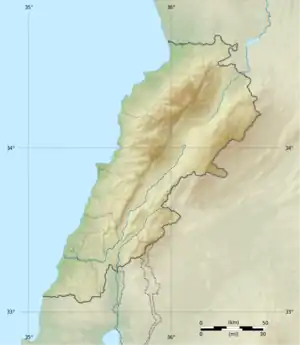 Location of Belat temple in Lebanon 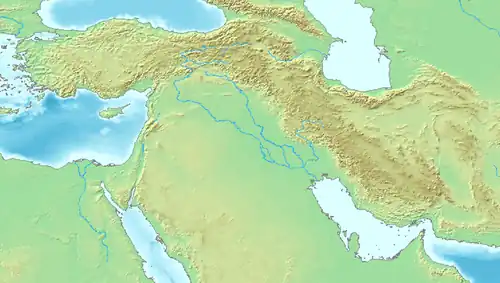 Belat temple (Near East) | |
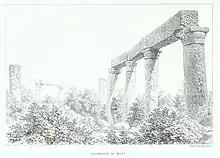
.jpg.webp)
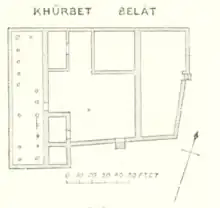
Belat is a ruined temple of unknown identification in southern Lebanon, between Marwahin and Ramyah. H. H. Kitchener described its location as "on top of a very commanding, steep, and narrow ridge, difficult of access... in this, the wildest part of the country".[1]
Kitchener and Ernest Renan considered it perhaps the finest example of a "high place" in the Galilee.[1][2][3]
Description
Descriptions of the temple in the mid-19th century describe the remains of 16 columns,[2] with 10 still standing in 1852, of which four on the east and three on the northwest still held architraves with Doric-style capitals.[4] In 1858 when Van de Velde visited, only nine of the columns were still standing.[5] In 1877 when H. H. Kitchener visited, only six columns still bore an architrave.[6]
The temple measured approximately 27.5m by 7m (90 ft x 22 ft, with the supporting platform extending 2m (7 ft) beyond the row of columns. The columns are approximately 4m (12 ft) high and 30cm (1 ft) in diameter, standing 2m (7 feet) apart. Including the architrave the total height was 4.5m (14 1/2 ft).[2] It was built from the common limestone of the region.[4]
Interpretations
In his 1852 travels to the region, Edward Robinson wrote:
The whole area is now full of fallen columns, architraves, and the like; but there does not appear to have been any interior building or fane. The stones are exceedingly worn by the weather, and there is the appearance of great rudeness in architecture. No sculpture is to be found except the columns; nor any trace of inscriptions. There is a cistern roughly hewn, in which we found water. Some traces of a small village are seen nearby; and a few hewn stones. We saw also a single sarcophagus sunk in a rock, with a rudely formed lid. This is a singular ruin, and hard to be accounted for. It has no resemblance to the heathen temples in Lebanon and Anti-Lebanon...[4]
Ernest Renan wrote in his Mission de Phénicie
The height of Bélat possesses the most striking ruin in the whole country... All the stones, or nearly all, are scattered about the hill, and one could almost rebuild the temple. This picturesque mass of ruins... ought to be thoroughly examined... Bélat was very probably dedicated to the Magna Dea Calestis, or Venus (Βλάττα ὄνομα ̓Αφροδίτης κατὰ τοὺς φοίνικας, Lydus de Mens. § 24), or at least to some goddess... I am inclined to believe that these buildings belong to the Ptolemaic or Seleucide period. The Roman period would have produced something more correct. However that may be, Bélat is the finest example of a "high place" that the country has to show.[2][3]
They were described by H. H. Kitchener in 1877 as "The most extraordinary ruins of this neighbourhood". He compared it to the columns at the Kfar Bar'am synagogue and [6] to those at the Cathedral at Tyre.[1] He described it as "one of the most perfect and earliest specimens of a temple dedicated to some deity worshipped on this "high place," and attended by a number of priests or votaries who were lodged in the surrounding buildings."[1]
E. W. G. Masterman concluded that it was a pagan temple, which pre-dated and may have influenced the architecture of the later Jewish synagogues in the Galilee.[7]
W. F. Albright proposed in 1921 that Belat might be biblical Beth-Anath,[8] but later changed his mind, locating Beth-Anath at Bi'ina (Dayr al Ba'ana).[9]
.jpg.webp)
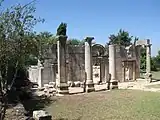
References
- 1 2 3 4 Kitchener, H. H. (1878). "Synagogues of Galilee" (PDF). Palestine Exploration Quarterly. Informa UK Limited. 10 (3): 123–129. doi:10.1179/peq.1878.10.3.123. ISSN 0031-0328.
the ruins at Belat, where the peculiar double columns again occur at both ends of a long colonnade. It was described by me in Quarterly Statement, October, 1877, p. 166, and the only photograph of these interesting remains is now in the Palestine Exploration Fund series. Though this building has some points of resemblance to synagogues, it is not, in my opinion, one of that class of buildings. In the first place it is longer and narrower than any known synagogue, the want of mouldings on the architrave, the archaic form of the capitals, and the general appearance of the building, seem to point to a much earlier date than that at which the synagogues were erected. The aisle or passage between the columns is made wider than in synagogues, and there is only one specimen (the small synagogue at Kefr Bir'im) where only two rows of columns occur. There is no sign of a southern doorway, though there is some reason to suppose that the entrance was in the centre of the eastern side, which is, as before pointed out, unlike the generality of synagogues. On the eastern side of this building, there are the remains of buildings enclosing a courtyard containing a large well that resembles such as one would expect to find of a monastery or castle. The situation, on the top of a very commanding, steep, and narrow ridge, difficult of access, is unlikely to have been the site of an important town, of which there are no traces. From these considerations I am led to the supposition that we have here one of the most perfect and earliest specimens of a temple dedicated to some deity worshipped on this "high place," and attended by a number of priests or votaries who were lodged in the surrounding buildings. To its isolation in this, the wildest part of the country, is probably due its preservation up to this time. It seems probable that from this and other specimens of the same class then existing, the architects copied those peculiar double columns that are always found terminating the colonnades in synagogues. Another fact pointing to this view of the case may be derived from the enormous monolithic double columns of red granite now lying in the ruins of the cathedral at Tyre. These were certainly not made for the cathedral, as all the interior decoration of that building was of white marble. They must have been taken from some building, or, more probably, were found lying, half covered with sand, on the site, when the cathedral was about to be built, and, from their great size and beauty, were used in that building. by the Christians who did not know their Pagan origin. We then come to the question, Were they not used in a synagogue formerly on this spot? If so, the Jews of that time were able to import from a distant country; probably Egypt, larger monoliths of more beautiful marble than any other race had been capable of bringing to the country. In no synagogue. has any marble been found, the hard limestone of the country is always used, and the columns and door-posts, though of monoliths, are nothing like the stupendous size of these enormous blocks of granite. It appears to me that these columns are the remains of a very early and most magnificent temple, dedicated to some unknown deity. The remains at Belât (within sight) appear to have been an offshoot and, probably, a copy of this temple. What mysterious religion was inculcated at these places there is no evidence to show.
- 1 2 3 4 Survey of Western Palestine, vol 1, page 171-173
- 1 2 Mission de Phenice, p.686-687
- 1 2 3 Robinson, E.; Smith, E. (1856). Later Biblical Researches in Palestine and the Adjacent Regions: A Journal of Travels in the Year 1852. J. Murray. p. 65. Retrieved 23 February 2023.
- ↑ Van de Velde, C.W.M. (1858). Memoir to Accompany the Map of the Holy Land. Justus Perthes. p. 103. Retrieved 23 February 2023.
- 1 2 Lieut. H.H. Kitchener [1850-1916], "Lieutenant Kitchener's Reports: IV - P.E.F. Camp, Taiyebeh, 30th May, 1877," Palestine Exploration Fund Quarterly Statement 9.4 (Oct. 1877): 166: "The entrance was probably in the centre of the eastern side, where two columns are squared on the outside--it was probably double, with a round column between. The end columns at both ends of the colonnade were squared on the outside, forming a double column on the inside, exactly the same as in Jewish synagogues, such as at Kefr Ber'am, where the southern columns of the portico were two double columns corresponding with those at the north end of the building. Another point of resemblance is the direction of the colonnade, being within twelve degrees of north and south."
- ↑ Masterman, Ernest William Gurney (1908). "The Ancient Jewish Synagogues". The Biblical World. University of Chicago Press. 32 (2): 87–102. ISSN 0190-3578. JSTOR 3141884.
The important buildings at Kades, Yarun, and Belat, once thought to be synagogues, are certainly not Jewish, and probably were all pagan temples, that at Yarun having been at a later period converted into a Christian basilica. Each of these three buildings preserves some architectural features common to the synagogue group. At Kades we find sculptured vine leaves with grape clusters as well as a fine eagle upon the lintel; at Yarun the beautiful carved palm trees with dates remind us much of similar work at Tell Hum; at Belat, among the sixteen columns on this lonely height, the same double "clustered" columns so characteristic of the synagogues occur. Indeed, this may, as Kitchener suggests, be the clew to the introduction of this special feature into Jewish architecture. Belat is within sight of Tyre, where similar gigantic "clustered" columns of red granite (afterward used in a Christian cathedral) once formed a part of the great temple of Melcarth whom, we read, to "was worshiped at Tyre in the form of two pillars."
- ↑ Journal of the Palestine Oriental Society, 1921, p.55, note 3
- ↑ Albright, W. F. (1923), p. 19 (note2)
External links
- Survey of Western Palestine, Map 3: IAA, Wikimedia commons
